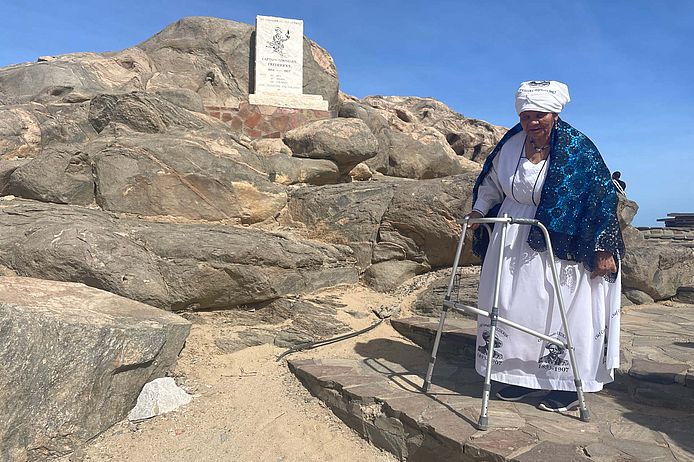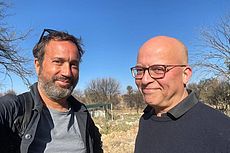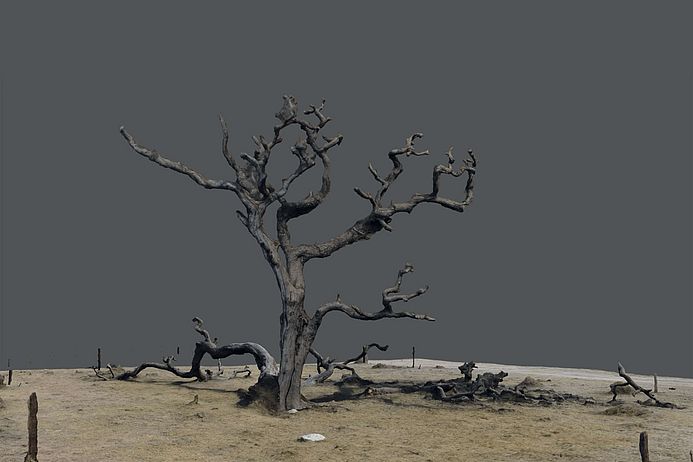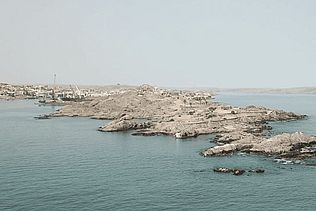By Tsafrir Cohen and Eyal Weizman
Europe’s historical memory and culture of remembrance are characterised by the absence of historical justice for the exclusion and oppression suffered, which began with the dawn of modernity and which continue to shape the fate of many millions of people down to this very day. At the heart of this history is the crime of colonialism under which the countries and regions of the Global South live and suffer - under the long shadow it casts and the continued impact it has today.
Few countries symbolise this better in the German debate than Namibia. “Making amends” in the literal sense is impossible, but there has certainly been no serious attempt to mend a relationship damaged by the violence of colonialism so far either. For all the gushing national pride in its culture of remembrance, the history of German colonialism is but a side note in contemporary German historiography. Not even basic rudimentary knowledge of the first German genocide can be assumed.
And yet, this year marks the 120th anniversary of the events leading to the first genocide of the 20th century. It was waged against the Ovaherero and Nama peoples in an area that Germany had colonised as “South West Africa” – present-day Namibia. As part of the European “race for Africa”, the German Empire established colonies encompassing present-day Togo, Cameroon, Tanzania, Rwanda, Burundi and Namibia.
The first genocide of the 20th century
The region in the south-west of the continent was seen as the epitome of what in 1897 German geographer Friedrich Ratzel described as “Lebensraum” or “living space”: an area laid claim to for the preservation of one’s own people in line with the social Darwinist ideology of “survival of the fittest”. For German colonization to be possible, the indigenous peoples had to be cleared out of the way. To begin with, land was taken bit by bit through forced protection and purchase agreements, threats, bribes and massacres. South West Africa gradually emerged as a mesh of farms, mission stations, mineral and diamond mines and military fortresses. For Ratzel, it was a place where the “German race” could cement its character, whilst the local population were regarded as “sub-humans” who could be exploited, driven out or exterminated at will.
On 12 January 1904, an Ovaherero uprising broke out under the leadership of Samuel Maharero. More than a hundred soldiers and settlers, mostly farmers and missionaries, were killed in the days that followed. The so-called imperial “Schutztruppe” or “protection force” was forced to beat a retreat. Humiliated, Germany began to plan its retribution for these acts of anti-colonial resistance. In June 1904, General Lothar von Trotha, a colonial officer who had made a name for himself for his part in the brutal suppression of the Boxer Rebellion in China, arrived in South West Africa, vowing to wipe out “the rebellious tribes in streams of blood”.
In August 1904, an estimated thirty thousand Ovaherero sought refuge at the foot of the Waterberg Plateau. The Schutztruppe cut off their escape route to the west, forcing men, women and children into the Kalahari Desert, where they were hunted down and shot. On 2 October, Trotha issued the infamous extermination order to his troops: “Within the German border, every Herero with or without a gun, with or without cattle, will be shot, I won’t take any more women and children, I will drive them back to their people or order them to be shot.” And so it was. In the months that followed, many Ovaherero were shot, others died after drinking water from wells poisoned by German troops. And a large number died of thirst and starvation in the desert they had been driven into.
The traditional leaders of the Nama and Ovaherero do not date the start of the genocide to the attack in Waterberg, but to a little-known attack eleven years before. On 12 April 1893, a Schutztruppe contingent attacked the Nama settlement of Nâ‡gâs - Hornkranz in German. It was the seat of “Captain” Hendrik Witbooi of the Witbooi Nama people, who had rejected all German “offers of protection” and was thus deemed guilty of rebellion by the German colonists. The Germans concluded that the only way to stop the “rebellious natives” was to wipe them out. So they destroyed the settlement, murdering women, children and elderly people. In the years that followed, the Nama tribes continued to resist German rule under the leadership of Witbooi and Jacobus Morenga, and on 22 April 1905 Trotha issued the second extermination order, this time against the Nama.
The surviving Nama and Ovaherero were sent to concentration camps, where they were used as slave labourers to build roads, railways, farms and administrative posts of the colony. More than half of the inmates died within a year. The deadliest camp was probably on Shark Island, a windy and exposed peninsula near the South Atlantic harbour town of Lüderitz where the inmates were left defenceless against the freezing cold, starved, beaten, raped and executed. Women were forced to boil the severed heads of corpses - some of them from their own relatives - and scrape off the flesh with shards of glass. The skulls were sent to universities and anthropological collections in Germany for racialist research, where most of them still remain today.
Unrecognised and uncompensated
By the end of the German campaign in 1908, over 65,000 Ovaherero, more than two thirds of the population, and 10,000 Nama had been killed. For decades, silence prevailed over these genocidal crimes. It is thanks to years of struggle by Namibian and German civil society groups that light is increasingly being shed on this blind spot in German history. In 2015, the German government stated its willingness to acknowledge its “moral responsibility for the colonisation of Namibia” and to apologise “for the historical developments that led to genocidal conditions between 1904 and 1908”. The words were carefully chosen. Moral responsibility does not constitute legal responsibility and genocidal conditions are not genocide.

The events of 1904 to 1908, so it was argued, could only be considered genocide from today’s perspective, thus relying on a legal nuance that has long been challenged in cases of genocide and slavery: the principle that a legal matter must be judged on the basis of the laws in force at the time of the deed. Germany thus argued that the UN Genocide Convention had not entered into force until 1948 and so could not be applied to the genocide in South West Africa, which had taken place prior to this. A similar argument was made by Eichmann at his trial in Jerusalem: as Hitler’s orders had had “legal force” in the Third Reich, he had acted in accordance with the laws at the time.
Rehabilitation and reparation
Even more egregious is another legal volte-face: under the 1889 Hague Convention the mass killing of civilians during a war was deemed illegal – so including at the beginning of the 20th century. However, as international law referred to wars between “civilised peoples”, this offence did not apply in the case of colonial violence against an indigenous population. Germany therefore argued that the crimes perpetrated in South West Africa had to be judged not by modern legal standards, but instead according to the racist laws of the colonial period.
There is method to the German government’s strategy of not denying a “historical genocide” but by all means its justiciability. It allows Germany to shirk any obligation to pay reparations or help make amends. As a sign of goodwill, Berlin instead announced an agreement to provide EUR 1.1 billion in development aid over a period of thirty years. This was enshrined in a joint declaration by the German and Namibian governments in 2021. Development, the West’s favourite magic word and promise.
The Ovaherero and Nama were once rich in land, livestock and culture. Colonisation ruined this wealth and created a “development need”. medico partner Sima Luipert from the Nama Traditional Leaders Association (NTLA) puts it like this: “Development is the biggest lie by the North. It is the purported generosity of a civilisation that is based on our oppression.” Some communities responded to the German offer by demanding that Germany buy their former lands from the descendants of German settlers and return them.
The genocides in South West Africa have also gone unrecognised and uncompensated in the German culture of remembrance, which constantly congratulates itself and lectures others. In reality, this history is draped in a cloak of silence and amnesia. It has not been sufficiently researched, nor is it fully taught or told. Be it in academia, art or politics: the crimes in South West Africa are far away and a long time ago. Even in Namibia itself, the genocides are far from having been addressed. The ancestral land of the victims remained in the possession of German settlers, including former officers who participated in the genocide, not just during South African apartheid. Even 34 years after independence, around 4,500 Europeans still own 70 per cent of farmland.
In the historical narrative of the SWAPO-led government, its own struggle against apartheid is very much at the fore; Germany’s colonial crimes barely register. As such, the affected areas continue to be neglected today. It also means that there are hardly any forms or sites of remembrance. Evidence of the colonial rule of the past is being lost. Shark Island, for instance, is a popular tourist destination with a state-run campsite which many people visit in total ignorance of what once happened here. But there is nothing to remind them of it either.
It is a cynical twist that the peninsula is now to become home to a major German energy project: Where the camps once stood, a dock is to be built through which liquid hydrogen produced in Namibia is to be transported to Europe’s energy-hungry industry. It is hard to imagine a more extreme greenwashing of this dark history.

The descendants of the victims of the genocide have always put up a fight: they founded towns in the cramped “homelands” assigned to them bearing the names of their ancestral homes and have upheld their demands for reparations from Germany and the right to return to their land. They have also opposed the German-Namibian negotiations on the genocide being conducted pretty much without the involvement of their representatives. An agreement between the two incumbent governments in Namibia and Germany based on the forecited German-Namibian declaration met with their fierce opposition and has not yet been approved by the Namibian parliament for this reason.
Forensic Architecture and medico are working with the affected communities to make the parts of their history that have little place in the collective memory seen and heard. In a transnational collaboration with the Ovaherero Traditional Authority (OTA) and the NTLA, supported by medico, Forensic Architecture and its Berlin-based sister group Forensis have integrated archive photos and testimonies from the traditional oral tradition into 3D models of sites of the atrocities, destroyed villages and mass graves. Their results are the beginning of a series of digital evidence to reconstruct the genocide.
A world memory
Acknowledging the genocide as well as remembrance and reparation work would not only bring long-overdue historical justice to the Nama and Ovaherero. They could mark the end of German colonialism amnesia, including in relation to the atrocities against the San people in Namibia or the hundreds of thousands of victims of the suppression of the Maji Maji uprising in German East Africa (1905-1907), present-day Tanzania, and beyond the African continent.
Nothing less than a deeper understanding and broader self-reflection on German history is needed. The interlinkages and guilt resulting from the obvious links between the crimes of the Shoah and the genocide in Namibia are diverse and many: Many of the key elements of the Nazi system - the systematic extermination of peoples deemed racially inferior, racist and eugenic theories and practices, the concept of Lebensraum, transporting people in livestock wagons to perform forced labour in concentration camps - had been applied in South West Africa half a century before the Shoah. Back in 1951, Hannah Arendt argued that European imperialism played a crucial role in the development of Nazi totalitarianism and the genocides associated with it. And Aimé Césaire described European fascism as colonial violence returning home.
But today it is by no means a matter of just making amends for historical guilt, it is about embarking on a different future. Black Lives Matter and numerous other movements around the world are helping to integrate the violent history of colonialism into the West’s preception of itself - in cities, at universities, in everyday life and in the media. Maybe it sounds utopian, but this could be constitutive for an equal “world memory” (Charlotte Wiedemann), allowing us to learn not only to interpret and tell history together from Frankfurt or Windhoek, but also to act together and combat our present of continuing asymmetrical relations of power and domination that continue to be influenced by colonialism. Our partners from NTLA and OTA are ready to do just that: “We are not laying claim to singularity, we are striving for global justice, solidarity and universal freedom.”
medico is currently supporting the “Nama Traditional Leaders Association” (NTLA) in organising the Genocide Memorial Walk in Lüderitz Bay, where Nama and Ovaherero from various regions of Namibia regularly come together as part of a self-organised culture of remembrance that keeps the memory of the genocide and its impacts alive and where this year Forensic Architecture also presented initial findings from a genocide study. At another meeting, a discussion was organised on the German-Namibian hydrogen project.

Tsafrir Cohen (right) is Executive Director of medico international. Eyal Weizman is a professor at the Goldsmiths Institute at the University of London and Director of Forensic Architecture (FA). The two traveled to Namibia together last year. medico and FA have been cooperating since 2023 to reconstruct German colonial crimes and their ongoing effects in present-day Namibia.



